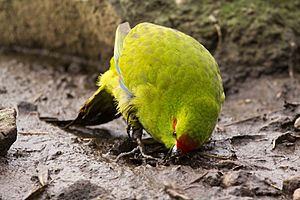Reischek's parakeet facts for kids
Quick facts for kids Reischek's parakeet |
|
|---|---|
 |
|
| Conservation status | |
 Range Restricted (NZ TCS) |
|
| Scientific classification | |
| Genus: |
Cyanoramphus
|
| Species: |
hochstetteri
|
The Reischek's parakeet (Cyanoramphus hochstetteri) is a small, green parrot. It lives only on Antipodes Island, a small island in New Zealand. This island is about 21 square kilometers in size. The parakeet shares its home with another, larger parrot, the Antipodes parakeet.
Contents
About Reischek's Parakeet
This special parakeet is named after Andreas Reischek. He was a brave explorer and collector of nature. Reischek found these parrots in 1888. He named the bird Platycercus hochstetteri. This name honored the son of his friend, Ferdinand von Hochstetter. Ferdinand was an Austrian geologist who studied New Zealand's land.
How Scientists Classify This Bird
For a long time, Reischek's parakeet was thought to be a type of red-crowned parakeet. It looks very similar to them. But in 2001, scientists studied the birds' DNA. They found that many red-crowned parakeet types were actually their own species.
One study even linked Reischek's parakeet to the Macquarie parakeet. However, it was later discovered that the samples used in that study were mixed up. The samples thought to be from Macquarie Island were actually from Antipodes Island. This showed that Reischek's parakeet is unique to its home.
What Reischek's Parakeets Eat
Reischek's parakeets are not picky eaters. They enjoy many different foods. They eat flowers, leaves, and seeds from tussock plants. They also eat berries found on the island.
These parakeets also like to eat small bugs. They find fly larvae (baby flies) in the droppings of penguins. They even scavenge on dead birds like petrels and albatrosses. This means they eat the remains of these birds.
Protecting Reischek's Parakeet
The number of Reischek's parakeets is currently healthy. However, they only live on one small island. This makes them vulnerable to certain dangers. For example, if rats or mice accidentally arrived on the island, they could harm the parakeets.
Because they live in such a small area, they are listed as 'range restricted'. This means their home range is very small. Protecting their island home is important for their future.
See also
 In Spanish: Perico de Reischek para niños
In Spanish: Perico de Reischek para niños

